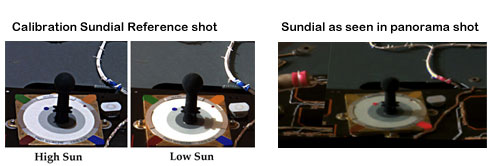TOP STORY: NASA Is Not Altering Mars Colors.: Mars Spirit Rover Picture analysis.
In this thread I will attempt to summarise my posts to the larger thread.
What are you talking about?
Ok, the initial alarm was raised after it was noticed that the color-calibration sundial mounted on the rover, looked quite markedly different in the Mars-Panorama shots compared to its regular appearance.

Immediately wide-ranging theories began to pop up. At this stage I knew very little of the particulars of the PanCam so I decided to go and see what the Horses mouth had to say. I sent out a swag of emails to the NASA marsrover team, the Athena Instrument team at Cornell University, and the long shot, an email to Assoc. Professor James Bell. Who is the Pancam Payload Element Lead for the mission.
Now, getting no response from the Athena team, and an automated response from the NASA team. I was amazed and delighted to see that Dr. Bell had indeed taken the time out of his busy schedule to help explain this quirk in the panorama pictures. His email response is below:
quote:Thanks for writing. The answer is that the color chips on the sundial have different colors in the near-infrared range of Pancam filters. For example, the blue chip is dark near 600 nm, where humans see red light, but is especially bright at 750 nm, which is used as 'red' for many Pancam images. So it appears pink in RGB composites. We chose the pigments for the chips on purpose this way, so they could provide different patterns of brightnesses regardless of which filters we used. The details of the colors of the pigments are published in a paper I wrote in the December issue of the Journal of Geophysical Research (Planets), in case you want more details...
All of us tired folks on the team are really happy that so many people around the world are following the mission and sending their support and encouragement...
Thanks,
Jim Bell
Cornell U.
Now, as far as the pink tab where the blue one should be, that email is infact the complete answer. But its not easily understandable to the layman. Below I will attempt to explain why this occurs.............
In this thread I will attempt to summarise my posts to the larger thread.
What are you talking about?
Ok, the initial alarm was raised after it was noticed that the color-calibration sundial mounted on the rover, looked quite markedly different in the Mars-Panorama shots compared to its regular appearance.

Immediately wide-ranging theories began to pop up. At this stage I knew very little of the particulars of the PanCam so I decided to go and see what the Horses mouth had to say. I sent out a swag of emails to the NASA marsrover team, the Athena Instrument team at Cornell University, and the long shot, an email to Assoc. Professor James Bell. Who is the Pancam Payload Element Lead for the mission.
Now, getting no response from the Athena team, and an automated response from the NASA team. I was amazed and delighted to see that Dr. Bell had indeed taken the time out of his busy schedule to help explain this quirk in the panorama pictures. His email response is below:
quote:Thanks for writing. The answer is that the color chips on the sundial have different colors in the near-infrared range of Pancam filters. For example, the blue chip is dark near 600 nm, where humans see red light, but is especially bright at 750 nm, which is used as 'red' for many Pancam images. So it appears pink in RGB composites. We chose the pigments for the chips on purpose this way, so they could provide different patterns of brightnesses regardless of which filters we used. The details of the colors of the pigments are published in a paper I wrote in the December issue of the Journal of Geophysical Research (Planets), in case you want more details...
All of us tired folks on the team are really happy that so many people around the world are following the mission and sending their support and encouragement...
Thanks,
Jim Bell
Cornell U.
Now, as far as the pink tab where the blue one should be, that email is infact the complete answer. But its not easily understandable to the layman. Below I will attempt to explain why this occurs.............
Comments